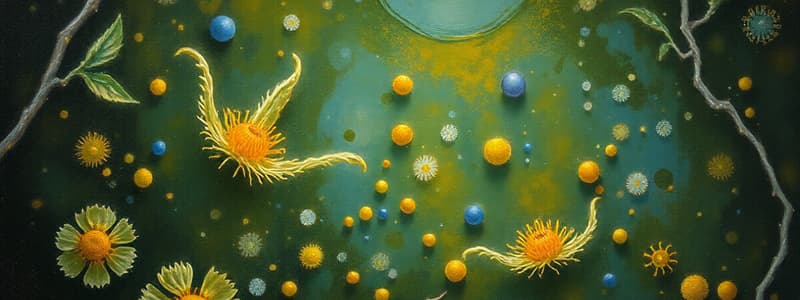Podcast
Questions and Answers
What characteristic of life is demonstrated by microorganisms using energy?
What characteristic of life is demonstrated by microorganisms using energy?
- Organization
- Homeostasis
- Growth and Development
- Metabolism (correct)
Which kingdom includes both bacteria and archaea?
Which kingdom includes both bacteria and archaea?
- Fungi
- Protista
- Monera (correct)
- Animalia
Which feature distinguishes eukaryotes from prokaryotes?
Which feature distinguishes eukaryotes from prokaryotes?
- Free-floating DNA in prokaryotes
- Presence of a nucleus in eukaryotes (correct)
- Smaller size of eukaryotes
- Lack of organelles in eukaryotes
What is the primary reason we cannot see microorganisms without a microscope?
What is the primary reason we cannot see microorganisms without a microscope?
In a mutualistic relationship involving microorganisms, what is the outcome?
In a mutualistic relationship involving microorganisms, what is the outcome?
Flashcards
Properties of Life
Properties of Life
Characteristics that define living organisms, like metabolism and reproduction.
Prokaryotes
Prokaryotes
Single-celled organisms without a nucleus, such as bacteria.
Eukaryotes
Eukaryotes
Organisms with complex cells that contain a nucleus, including plants and animals.
Microorganism Diversity
Microorganism Diversity
Signup and view all the flashcards
Symbiosis
Symbiosis
Signup and view all the flashcards
Study Notes
Microorganisms: Tiny Titans of the Living World
- Microorganisms have a huge impact on the world, despite being small
- They are involved in ecosystems and human health
- Their functions include running ecosystems and influencing gut health
The Properties of Life
- Living things have specific traits, including organization, metabolism, growth, reproduction, homeostasis, response to stimuli, and evolution
- Cells are the basic building blocks of life
- Metabolism is the process by which living things use energy
- Growth and development occur across the life cycle of microorganisms
- Reproduction is how microorganisms create more of themselves
- Maintaining stability is homeostasis
- Responding to the environment is how living organisms adapt
- Evolution is how living things change over generations
The Kingdoms of Life
- There are five kingdoms in the classification system: Monera, Protista, Fungi, Plantae, Animalia
- Microorganisms play significant roles in several of these kingdoms
- Monera includes bacteria and archaea (prokaryotes)
- Protista includes algae, protozoa, and slime molds (eukaryotes)
- Fungi includes yeasts and molds
- Plantae includes microscopic algae
- Animalia includes some microbes such as rotifers
Prokaryotes vs. Eukaryotes: The Microscopic Showdown
- Prokaryotes are simple, single-celled organisms
- Eukaryotes are more complex, often multicellular organisms
- Prokaryotes lack a nucleus and membrane-bound organelles
- Eukaryotes have a nucleus and membrane-bound organelles
Prokaryotes
- Single-celled organisms like bacteria
- Lack a nucleus; DNA is free-floating
- Fewer organelles compared to eukaryotes
- Very small
Eukaryotes
- Single or multicellular organisms including plants, animals, fungi, and protists
- Have a nucleus to store DNA
- Numerous organelles
- Larger than prokaryotes
General Properties and Biodiversity of Microorganisms
- Microbes are present in soil, water, air, and even the human body
- They are invisible to the naked eye; microscopes are needed to view them
- Microorganisms, though small, form a large component of the biomass on Earth
- Different types exist, including bacteria, archaea, fungi, protists, and viruses
- Many show symbiosis with other organisms (mutualism, commensalism, parasitism)
Symbiosis: Microorganisms as Besties or Frenemies
- Mutualism: Both organisms benefit (e.g., gut bacteria helping digestion)
- Commensalism: One benefits, the other is unaffected (e.g., bacteria on skin)
- Parasitism: One benefits, the other is harmed (e.g., disease-causing bacteria)
Pathogens: The Bad Apples
- Pathogens are microorganisms that cause diseases
- Examples include bacteria that cause strep throat, and viruses that cause the flu
Saprophytic Role: Nature's Recycling Squad
- Saprophytes are organisms that break down dead or decaying matter
- These organisms play a crucial role in recycling nutrients
Studying That Suits You
Use AI to generate personalized quizzes and flashcards to suit your learning preferences.




